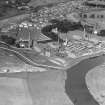Dalquhurn Print Works
Works (18th Century)
Site Name Dalquhurn Print Works
Classification Works (18th Century)
Alternative Name(s) Leval Engineering
Canmore ID 128405
Site Number NS37NE 72
NGR NS 3925 7765
Datum OSGB36 - NGR
Permalink http://canmore.org.uk/site/128405
- Council West Dunbartonshire
- Parish Cardross (West Dumbartonshire)
- Former Region Strathclyde
- Former District Dumbarton
- Former County Dunbartonshire
NS37NE 72 392 776
Dalquhurn Print Works: calico printing, 1715 onwards. Part occupied by Feval Engineering Limited, in liquidation at time of visit.
Visited and photographed, J R Hume, University of Strathclyde, 8 September 1975.
Information from MS/749 (Dunbartonshire, Cardross parish, Dalquhurn Print Works), photographic contact prints attached (JR Hume index H75/70/1-16; 71/1-16; 69/12-16; negatives with reporter, J R Hume) of buildings and machinery (sheet metal cutter and guillotine) within engineering works.
(Location cited as NS392 776). These buildings were erected as a bleachworks in 1715 by one Andrew Johnstone. This large much altered group of brick and rubble buldings. the most striking in Hume's view was a 4 storey, 9-bay, red-and-white brick block at the entrance. There were also two engine houses, one of which had cast-iron roof beams. The site is now an industrial estate.
J R Hume, 1976.
Desk Based Assessment (November 1999)
A desk-based study and field survey of Dalquhurn Bleachfields, Dying and Printing Works was carried out in November 1999 in advance of proposed development.
The bleachfields at Dalquhurn were established in 1715 and expanded to become one of the largest and most profitable industrial ventures in the Vale of Leven textile industry.
The site was largely demolished in the early 1990s and now less than 10 of the 40 or so buildings that stood on the site during its later 19th-century hey-day survive. The site has been colonised by trees and dense undergrowth in parts and piles of demolition rubble are located all over.
The site of the tomb of George Scott who was buried at Dalquhurn in 1767 on his request was desecrated in 1989 and 1991 and there is now no trace of it on the ground. His gravestone is currently broken into three pieces and under the cemetery tip at Alexandria Cemetery.
Forty sites were recorded in the field and a clear history of the site revealed by the desk study.
A full report has been deposited in the NMRS.
Sponsor: CRGP.
F Baker 2000


















































































